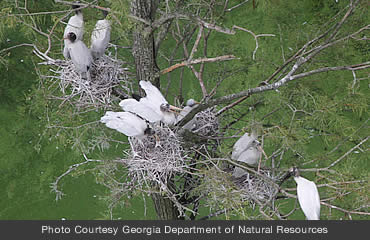Once nearly gone from the swamps in the Southeast, the wood stork has been making a comeback as wetlands are preserved and managed.
In Georgia, biologists surveying nesting colonies have seen a drop from the record-setting 2,932 nests documented in 2014, but an increase over the previous two years.
Wildlife biologist Tim Keyes, wood stork survey leader for the Georgia Department of Natural Resources Nongame Conservation Section, said aerial and ground surveys in May and June 2015 estimated 2,496 nests in 22 colonies, from Chatham to Mitchell County.
That’s good news for the distinctive long-beaked, bald-headed wading bird that is the only stork that breeds in North America.
The wood stork’s presence – clearly noticeable at nearly 4 feet tall with a 66-inch wingspan – is also an indicator of the health of the wetlands.
Wood storks nest in colonies, often with several stick nests in the same tree. Nests are built over water, a setting in which alligators unwittingly help protect the eggs and chicks above from raccoons and other predators.
Storks build a bulky nest of twigs in the forks of trees 3 to 50 feet above water, usually 20 to 25 inches in diameter, with interior surface lined with live leaves and small, pliable branches to prevent the eggs from slipping between the large twigs.
The wood stork’s late winter breeding season is timed to the Florida dry season when its fish prey becomes concentrated in shrinking pools.
 Wood storks can be found from coastal Mexico and northern Argentina throughout interior South America, the Caribbean islands of Cuba and Hispaniola, north to through Florida, Georgia and South Carolina.
Wood storks can be found from coastal Mexico and northern Argentina throughout interior South America, the Caribbean islands of Cuba and Hispaniola, north to through Florida, Georgia and South Carolina.
Florida claims the largest nesting population in the U.S. The best place to see nesting storks in Florida is at the Corkscrew Swamp Sanctuary maintained by the National Audubon Society near Naples.
Colonies are often located in swamps that do not permit ready access to see these nesting birds. Less common coastal colonies are more accessible to boat traffic.
In Louisiana, watching wood storks is possible during early August. That’s when the Louisiana Department of Wildlife and Fisheries and the U.S. Army Corps of Engineers open the South Farm area in the Shelburne Management Area for a day to give bird watchers and photographers an opportunity to view wildlife there.
Wood storks and other wading and shore birds are readily visible as a number of large moist soil impoundments which are flooded in the fall to provide habitat for water birds, especially shorebirds and waterfowl. Aside from seed bearing herbaceous plants, the developed habitat contains an abundance of small fish and crawfish, ideal food sources.
 The South Farm drawdown period is extended while the management strategy focuses on providing mud flats and very shallow water with concentrated prey for shorebirds (sandpipers) and wading birds (egrets, herons, spoonbills, storks and ibis).
The South Farm drawdown period is extended while the management strategy focuses on providing mud flats and very shallow water with concentrated prey for shorebirds (sandpipers) and wading birds (egrets, herons, spoonbills, storks and ibis).
Georgia colonies this year ranged in size from 442 nests at Harris Neck National Wildlife Refuge to 15 nests at a St. Catherines Island site. Colonies were documented in 12 Georgia counties: Brantley, Brooks, Camden, Chatham, Cook, Glynn, Jenkins, Liberty, McIntosh, Mitchell, Thomas and Worth.
Colonies in southwest Georgia depend more on rainfall and are less stable than those in coastal counties, where many wetlands used by storks are influenced by tides.
— Resources: Georgia Department of Natural Resources, Louisiana Department of Wildlife and Fisheries, Florida Fish and Wildlife Conservation Commission